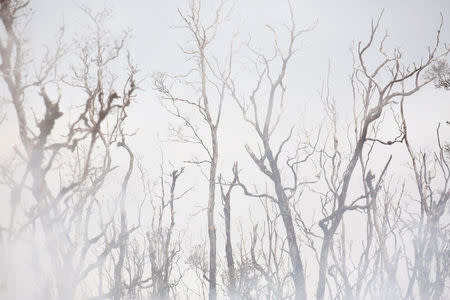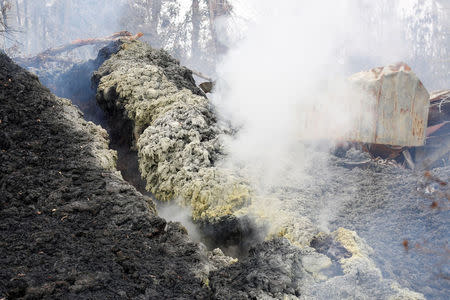Access roads at risk, Hawaii volcano could spur more evacuations
By Terray Sylvester PAHOA, Hawaii (Reuters) - Lava flowing from giant rips in the earth on the flank of Hawaii's Kilauea volcano threatened highways on Monday, raising the possibility that officials will order thousands more residents to evacuate before access routes are cut off. Since May 3 when Kilauea began erupting, 19 lava-spewing fissures have opened about 25 miles (40 km) from its summit, including one that tore through countryside close to houses on Monday in the Lower Puna area of Hawaii's Big Island. Steaming cracks along one of the area's main routes, Highway 132, have raised concerns a new fissure may develop there, which would imperil access for 2,000 people in the lower Puna area on the east of the island. If the highway is cut off, officials will start to plan for another major evacuation, Hawaii National Guard spokesman Major Jeff Hickman told reporters. "We've been telling them, 'evacuate if you can, because if we have to come in and get you, we'll be putting first responders at risk," Hickman said. Since the eruptions began, 37 structures have been destroyed and officials have ordered the evacuations of nearly 2,000 people, mostly in the hard-hit Leilani Estates area. The American Red Cross said 500 people sought refuge in its shelters on Sunday night because of worsening volcanic activity. "Eruption of lava continues from multiple points along the northeast end of the active fissure system," the Hawaiian Volcano Observatory said in a briefing. (GRAPHIC:Scorched earth - https://tmsnrt.rs/2IldVyS) 'LAVA BOMBS' Fountains of magma spouted "lava bombs" over 100 feet (30 meters) into the air and a narrow flow had traveled just under a mile (1.6 km) east-southeast by 6.30 a.m. (12.30 p.m. EDT), moving slowly towards the coast some two miles (3.2 km) away, the Observatory said. Residents from coastal communities fear the lava flow could block a dirt road, highway 137, that is their only way out after the main highway 130 was closed due to steaming cracks. "It's down to one gravel road, that's what also pushed us over the edge," said Rob Guzman, who with his husband Bob Kirk decided to leave their home in the Kalapana Seaview Estates subdivision around 3.5 miles (5.6 km) south of Leilani Estates. Clouds of toxic gas and constant small earthquakes have sent many residents fleeing, but some either cannot or will not go, said Hazen Komraus, president of the community association. "You can't hop in a car and drive your life, family, pets and job to another state," said Hazen, who described his area as one of the most diverse and tolerant in Hawaii. While residents deal with noxious gas and lava on the ground, the U.S. Geological Survey said that pent-up steam could cause an explosion at the volcano crater as the lava pool drops, launching a 20,000-foot (6,100-meter) plume that could spread debris over 12 miles (19 km). The ash plumes at the summit so far are rising only 4,000-6,000 feet (1,220-1,830 meters). Unlike other catastrophic eruptions, where huge volumes of ash were blown into the stratosphere and carried to distant locations, they are having no impact on weather elsewhere, Steve Brantley, the deputy scientist in charge for the USGS Hawaiian Volcano Observatory, told Reuters. (Reporting by Terray Sylvester in Pahoa and Jolyn Rosa in Honolulu; Additional reporting by Rich McKay in Atlanta; Writing by Andrew Hay in Taos, New Mexico; Editing by Bill Tarrant and Sandra Maler)





